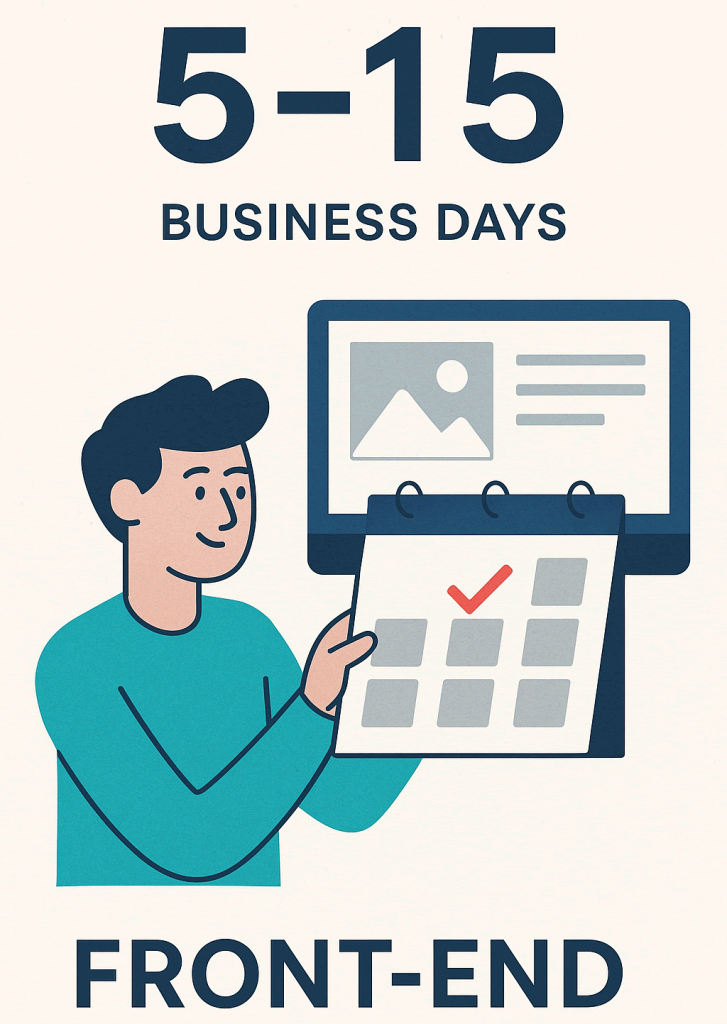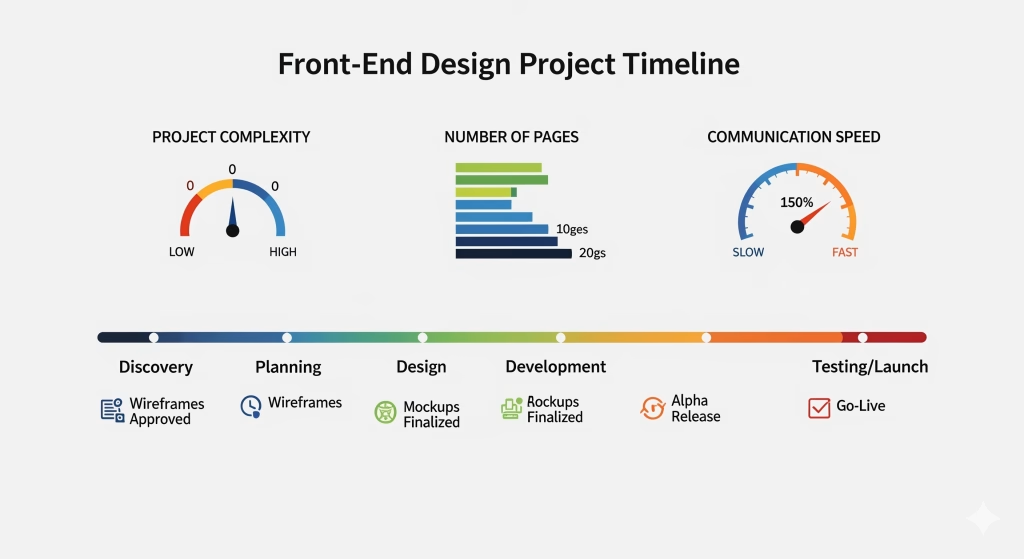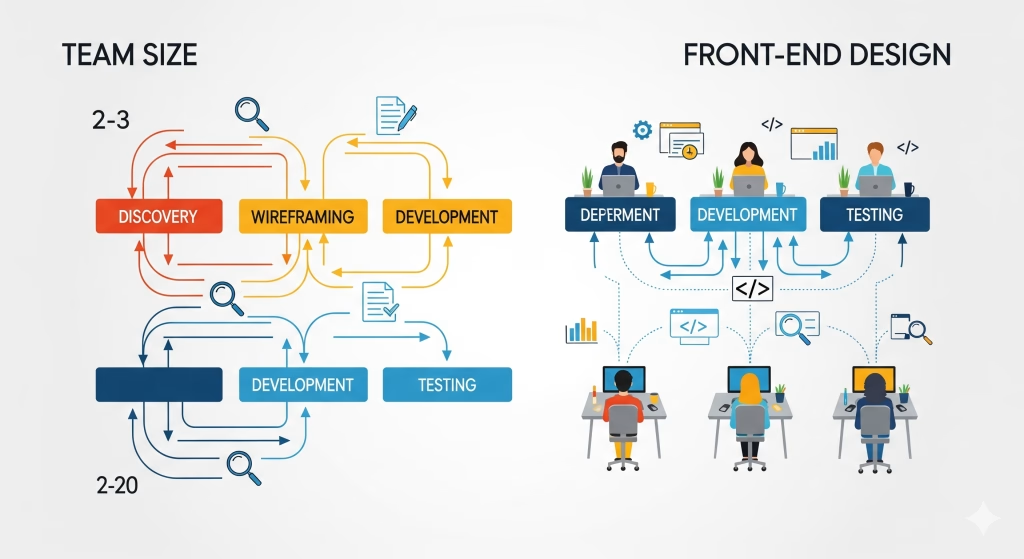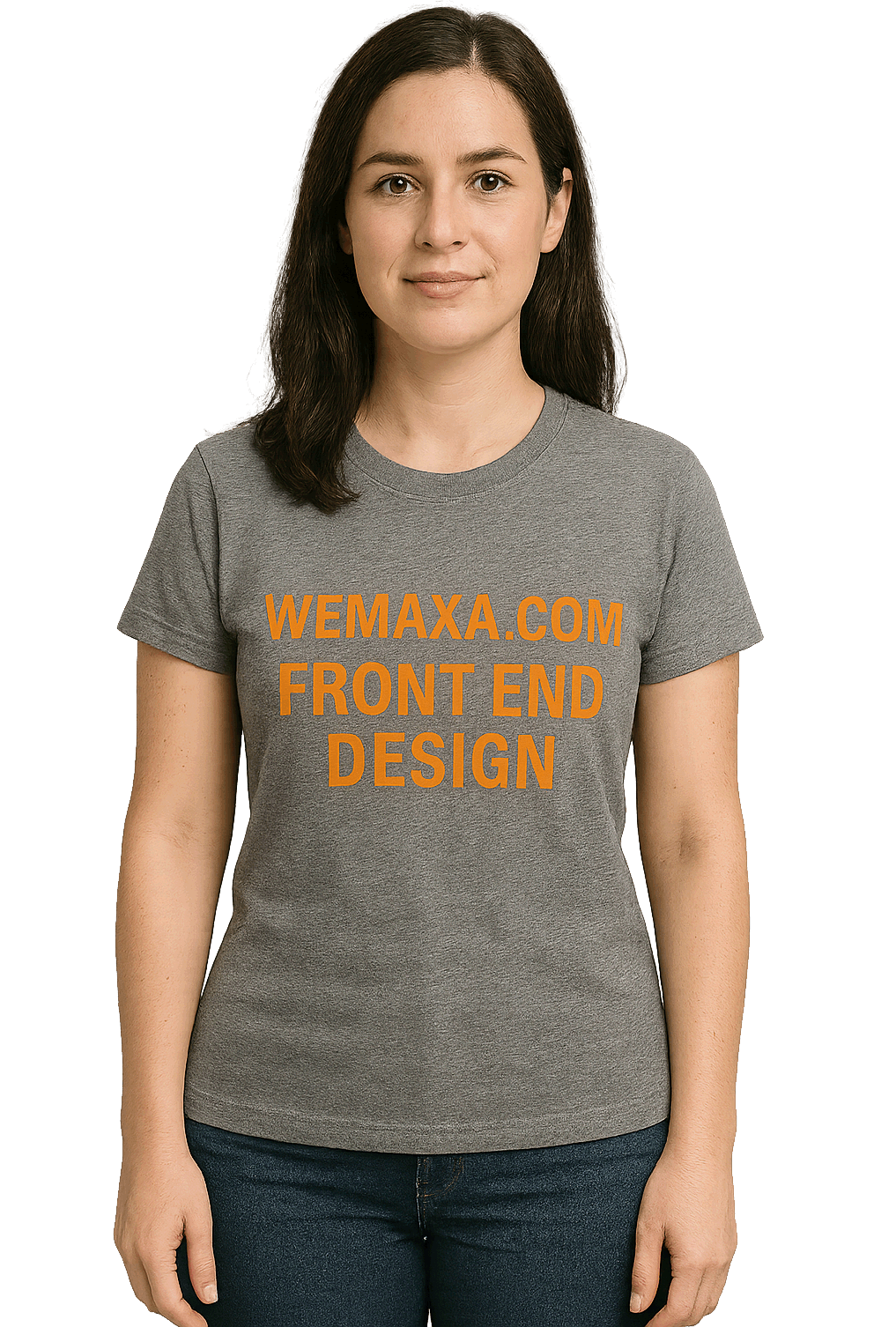The timeline for front-end design depends on several key factors, including the complexity of your project, the number of pages or features involved, and how clearly your requirements are defined. A simple brochure-style website with a few static pages may take just a few days to complete, while a larger, interactive platform with custom animations, forms, or integrations can require several weeks. Clear communication, fast feedback, and having your content and assets ready up front all help move the process along smoothly.

To keep everything on track, we typically break the project into stages: discovery and planning, wireframing or layout design, front-end development, and final testing. Each stage has its own goals and approval points, which gives you visibility into the progress and allows space for feedback. With a focused plan and open collaboration, even complex front-end design projects can stay on schedule and deliver polished, professional results.
- Provide all content (text/images) upfront.
- Limit revision rounds (agree on a max number in the contract).
- Use existing branding assets (logos, color codes).
- Opt for a template-based design (e.g., WordPress themes).
Team size and collaboration also play a role in how quickly the design comes together. If you’re working with a dedicated designer and developer, tasks can often be done in parallel, speeding up the process. On the other hand, projects that require multiple rounds of review, frequent changes, or coordination across different teams may take more time. It’s helpful to outline your priorities early so we can structure the timeline around what matters most to you.
- Basic site: ~2 weeks.
- Custom site: 1–2 months.
- Complex app: 2–6 months.
1. Simple Website (Brochure, Portfolio, Small Business)
- Time: 1–3 weeks
- Scope:
- Basic UI/UX design (homepage + 3-5 subpages).
- Mobile-responsive layout.
- Minimal animations (hover effects, simple transitions).
- No backend integration (static content).
2. Medium Complexity (Startup, SaaS Landing Page, E-commerce Lite)
- Time: 3–6 weeks
- Scope:
- Custom UI/UX with branded animations.
- Interactive components (sliders, filtered galleries).
- CMS integration (WordPress, Shopify).
- Basic SEO optimization.
3. Complex Project (Web App, Dashboard, Advanced E-commerce)
- Time: 6 weeks – 3+ months
- Scope:
- Dynamic front-end (React/Vue/Angular).
- API integrations (payment gateways, user accounts).
- Advanced animations/3D elements.
- Rigorous cross-browser/device testing.
Phases Breakdown
- Discovery (1–2 weeks): Requirements, wireframes, style guides.
- Design (2–4 weeks): Mockups, client feedback, revisions.
- Development (2–6 weeks): Coding, animations, responsiveness.
- Testing (1–2 weeks): Bug fixes, performance tweaks.
MORE LINKS:
Front end includes?
Mobile version of a site
Seo optimized design
Technology for frontend?
Match existing branding
I need animations?!
Preview the design
Provide source files
Typical include
TIMELINE FOR UI/UX WEB DESIGN
Understanding how long front-end design takes is a crucial step in web project planning, especially for businesses looking to optimize timelines and align deliverables with launch strategies. The duration for completing front-end work can vary immensely based on the type of website being built, the tools and frameworks involved, and the level of collaboration between clients, designers, and developers. For instance, a basic informational site with minimal user interaction and a limited number of pages may require only two to four weeks to complete, assuming that content and branding assets are readily available at the project’s onset. However, when additional layers of complexity are introduced such as custom animations, responsive layouts for dozens of breakpoints, or integration with APIs and third-party libraries the development time naturally expands. Not only do designers need to ensure a consistent and visually engaging user interface across all devices, but developers must also structure clean, semantic code that adheres to modern best practices, including accessibility standards, SEO optimization, and performance tuning. Additionally, stakeholder involvement plays a significant role: projects with frequent rounds of feedback, unclear requirements, or evolving scope tend to suffer from scope creep, which can add weeks to the timeline. A well-organized project begins with a transparent breakdown of phases, clear expectations, and the agility to adapt to challenges components that ultimately determine how quickly and efficiently front-end work can be completed. For more insight into typical front-end timelines and how these components interact, explore this comprehensive overview by Wemaxa.

Breaking the front-end process into clearly defined phases can provide a realistic perspective on the actual time investment required. The first of these stages is the discovery and planning phase, which often spans one to two weeks and serves as the foundational blueprint for everything that follows. During this time, teams collaborate to identify user personas, establish goals, define the project’s scope, and create wireframes or low-fidelity mockups that capture the basic structure of each page. While it may be tempting to rush through this stage, failing to plan thoroughly often results in costly revisions later. Once the framework is established, the project transitions into the high-fidelity design phase, where the visual elements typography, color schemes, iconography, imagery, layout composition, and interactivity come to life. This stage can take anywhere from two to four weeks, especially if custom assets are created from scratch or if multiple iterations are needed to satisfy branding requirements. After approval, front-end developers begin coding the visual layer into functioning web pages using HTML, CSS, and JavaScript (or component-based frameworks like React, Vue, or Svelte). Depending on the complexity, development can take another four to eight weeks. Developers must also account for mobile responsiveness, cross-browser compatibility, and accessibility compliance, all of which add to the time investment. To better understand how this timeline plays out across different project types, consider resources like this Shopify guide on building websites, which outlines planning strategies and key milestones.
It’s important to understand that several external and internal factors can significantly influence the overall duration of front-end design and development. One of the most common bottlenecks is the lack of finalized content at the outset of the project. If clients delay in providing written copy, imagery, or branding guidelines, designers and developers are often forced to halt their work or make temporary assumptions, which increases the likelihood of costly revisions later. Moreover, the decision to use pre-made themes versus custom UI design also has major implications for speed and flexibility. For example, using a well-optimized WordPress theme can shave weeks off the timeline because much of the styling and responsiveness is already built-in. However, custom designs offer far more flexibility and branding power but require additional time for ideation, iteration, and precise execution. Additionally, collaboration logistics such as how frequently the team meets, how decisions are made, and whether feedback is timely can either streamline or prolong a project. According to this Graticle article on web design timelines, projects that experience scope creep or communication breakdowns often exceed their original estimates by weeks or even months. Therefore, aligning team expectations, securing upfront approvals, and keeping feedback loops tight are crucial for staying on track and meeting delivery goals without compromising quality or user experience.

To further illustrate the variability in timelines, consider a real-world scenario: a mid-sized SaaS company aiming to launch a new marketing site for a product update. The project scope includes a homepage, features page, pricing page, support documentation, a blog section, and multiple calls to action all requiring unique layouts, interactive elements, and backend CMS integration. In such cases, the initial planning and content strategy might take two weeks, followed by another three to four weeks for custom UI/UX design. Development then typically spans six to eight weeks, given the need to implement responsive design, smooth transitions, scalable components, and browser testing across major platforms. When you add QA testing, stakeholder signoff, SEO optimization, and deployment, the timeline can easily reach 12 to 14 weeks. And this assumes everything goes smoothly no unexpected changes to the feature set, no delays in content, and no major revisions after launch testing. For larger, enterprise-level sites or apps involving dashboards, user authentication, and dynamic data rendering, timelines can stretch beyond six months. In these contexts, proper expectation setting is vital not only for client satisfaction but also for maintaining team morale. Tools like Gantt charts, sprint planning boards, and milestone tracking apps help visualize progress and align stakeholders throughout the process. If you’re unsure whether your own project falls into the short-term or long-term category, resources such as this in-depth timeline guide from Webfor can help clarify what to expect based on your goals and constraints.
In conclusion, while there is no one-size-fits-all answer to how long front-end design takes, establishing a clear, phased process can help manage both time and expectations. Simpler sites may be turned around in two to four weeks, particularly when using pre-built tools and templates; medium-complexity projects typically require six to twelve weeks of careful design, development, and testing; and more sophisticated platforms, like full-scale web apps or high-traffic eCommerce sites, often demand three to six months or more of ongoing work. What ultimately determines the pace isn’t just the technical difficulty but the readiness of assets, the clarity of requirements, the communication between stakeholders, and the ability to manage revisions without derailing the overall schedule. As a best practice, it’s essential to document your assumptions early, build in buffer time for inevitable delays, and approach each phase with a mindset of iterative improvement. Whether you’re working with an internal team or hiring an external agency, transparency and flexibility are your best tools for ensuring your front-end design project remains efficient, engaging, and aligned with your brand goals.
Key Factors That Affect The Timeline
| Factor | Impact |
|---|---|
| Revisions | Each round adds 3–7 days. |
| Content Readiness | Delays if copy/images aren’t provided upfront. |
| Custom Designs | Faster with templates; slower for unique visuals. |
| Team Size | Solo freelancer vs. agency with dedicated roles. |
| Third-Party Dependencies | APIs, plugins, or client approvals can stall progress. |


